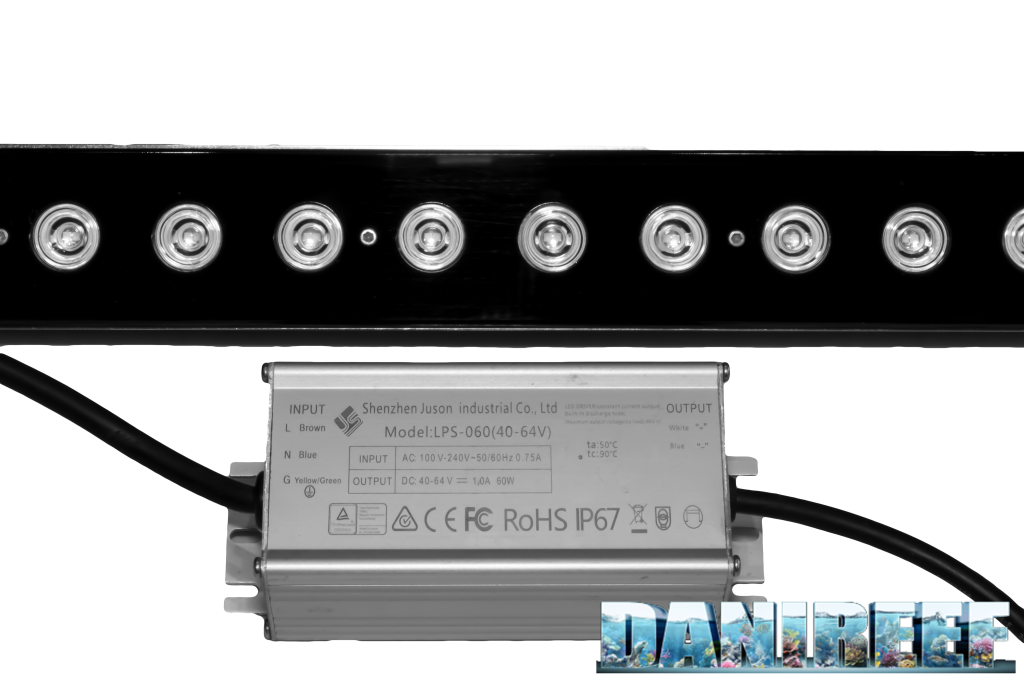
We had not yet tried these UV bars and were extremely curious to see the PAR value of the Orphek OR3 UV/Violet, especially since to our eyes the UV lights appear low in power but we know they have a high PAR value. Therefore, let us take a closer look.
Many parts of this review are very similar, to the other OR3 bars’, as the ceiling lights are nearly identical.
We also had a strong curiosity about these ceiling lights, and wanted to compare their differences with the other OR3 available to us, namely the Blue Sky The new Orphek OR3 Blue Sky LED bars in the DaniReef LAB – review, the Reef Day Plus Orphek OR3 Reef Day Plus LED bars in the DaniReef LAB – review and the Blue Plus, whose review you will see in the coming weeks. Having tested them all together we will in fact do closer posts than usual to tell you about them, otherwise we would drown you in numbers and stats.
The bars are beautiful, solid, and appear very well made, common to all OR3 bars; in fact the shell between the various bars is absolutely identical. Orphek has finally made a dimmer, which allows one to turn the dimming on and off, but without discriminating between the various colors. This is a dimmer that we have been anxiously waiting for, since, perhaps, it is the only thing these ceiling lights have been missing. Although, by the way, in LED bars the dimmer is much less important than in actual ceiling lights. But this is something we will see later, as we are testing it for you.
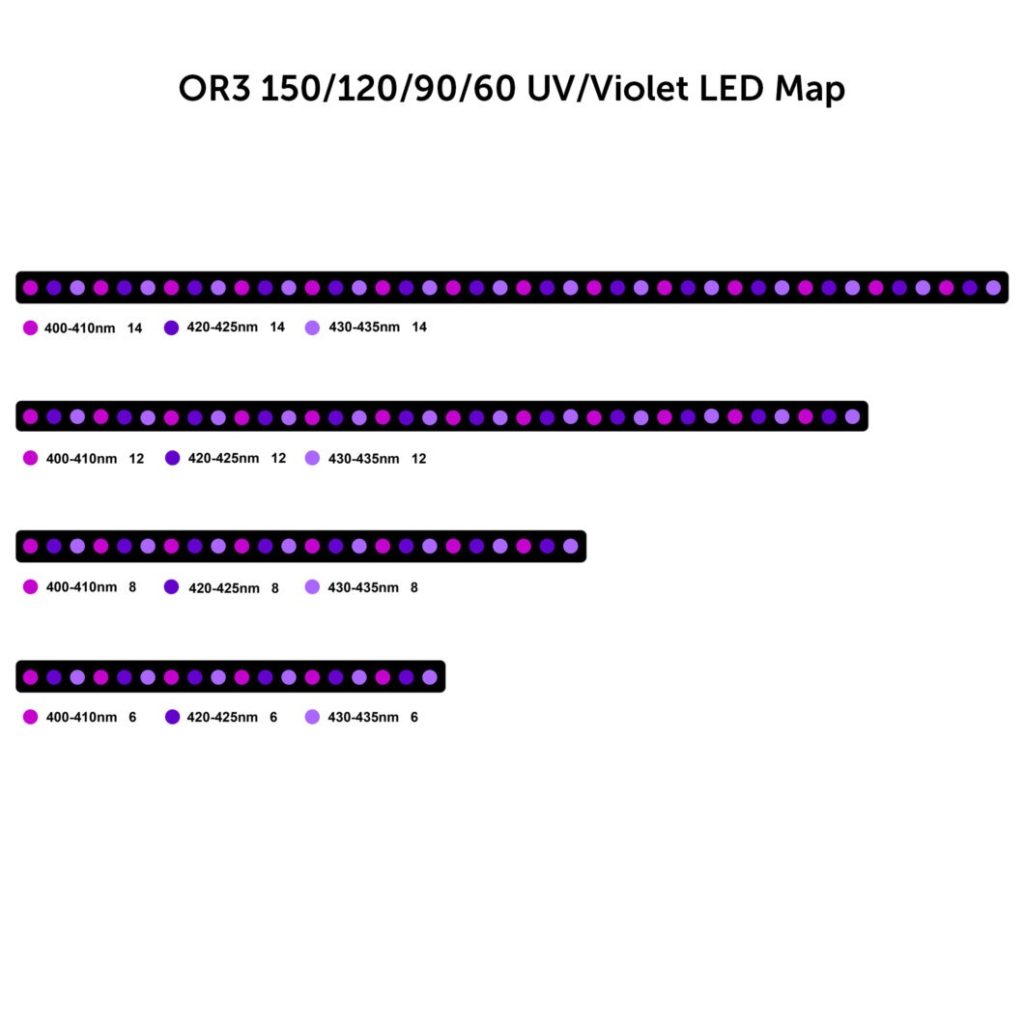
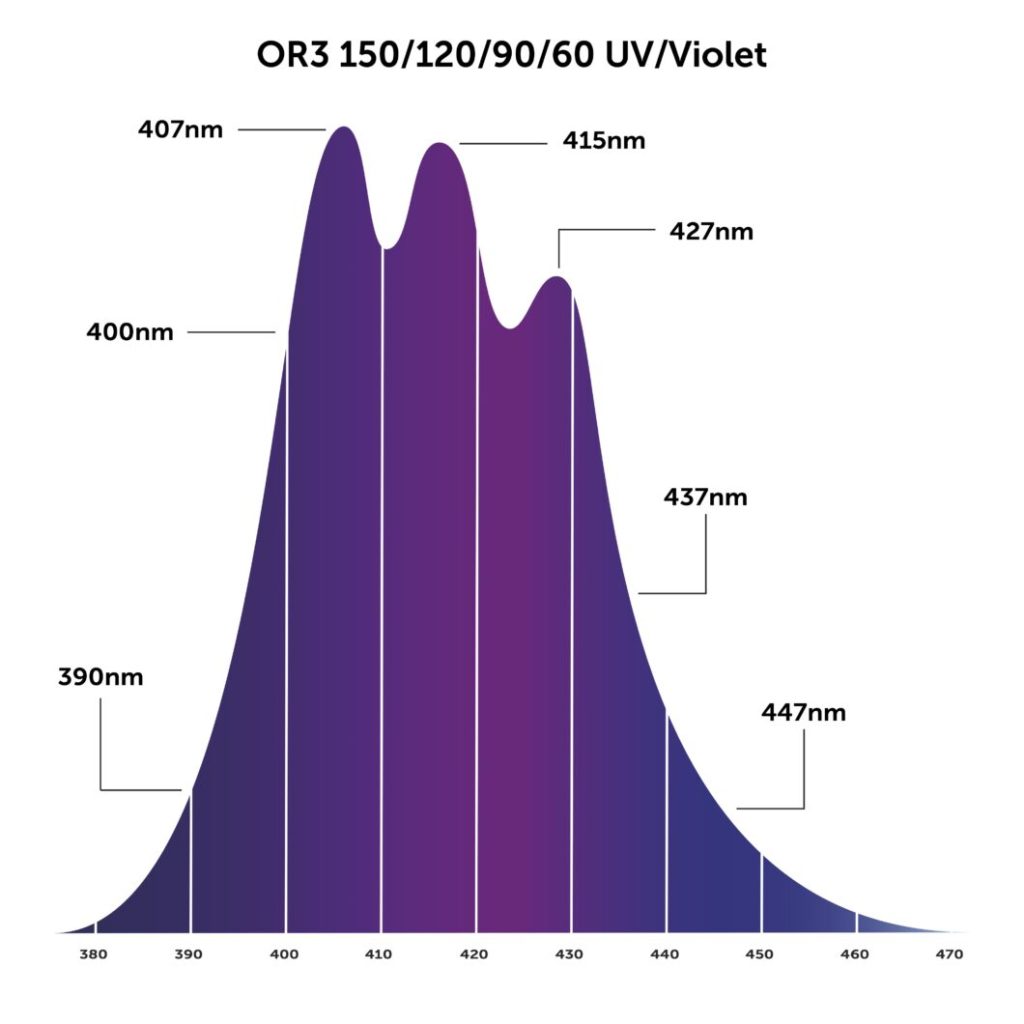
Technical Specifications Orphek OR3 UV/Violet LED Bars
- Driver: exterior;
- Input Voltage: 100-240VAC;
- Frequency: 50-60Hz;
- Consumption: 60 watts +-5%;
- Cos(phi) > 0.9;
- Input current (Amps) 0.55;
- Length: 123.5 cm;
- Width: 5 cm;
- Height: 3.6 cm;
- Weight: 2.3 kg;
- LEDs employed: 28x410nm, 8x430nm.
- Price to the public: 300 EUR for the 120 cm version, and it is the most expensive among the 4 OR3 bars.
The special feature of the Orphek OR3 UV/Violet
The new LED bar of the highly successful OR3 series has 410 to 430 nanometer LEDs. An avowedly UV/purple ceiling light, with the broadest fluorescent spectrum. Orphek says this coloration is very useful in photosynthesis, and has been found to be critical in stimulating fluorescent proteins in our corals.
As Orphek itself says: “Corals and anemones have at least two types of color compounds: fluorescent and non-fluorescent. Fluorescence occurs when a compound absorbs light and emits it (fluoresces) at a longer wavelength, so fluorescent compounds glow (or “burst”) under UV, violet or blue light, while non-fluorescent compounds do not, appearing in fact opaque under those wavelengths and are called chromoproteins. However, they are all proteins and are produced either by the coral or the anemone“.
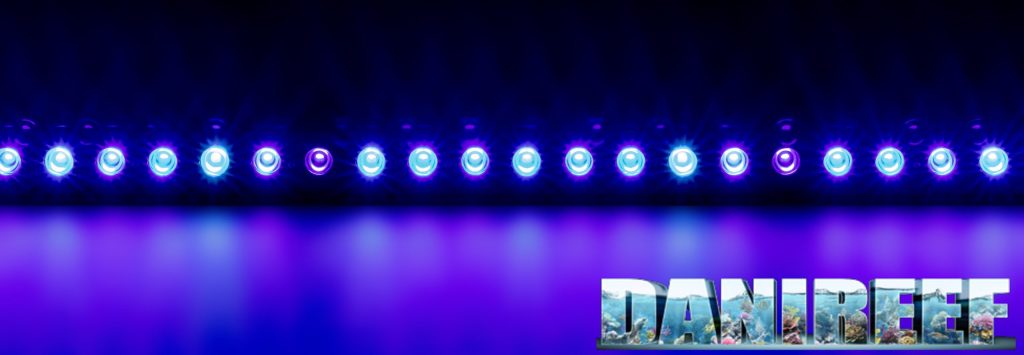
The suspension kit
The bars are sold together with a suspension kit, which is very short, so if you want to hang them from the ceiling, you need to buy an extension cord. It is a kit that is good for connecting to Orphek suspension arms, or to the kit for suspending them along with the Atlantik iCon. We’ve said it before, but we’ll say it again, the Orphek OR3 UV/Violet bars are beautifully constructed. The aluminum outer finish functions as a passive heatsink, and given the weight and volume of the aluminum, we are confident that these LED bars will never have overheating problems. The assembly is virtually perfect.
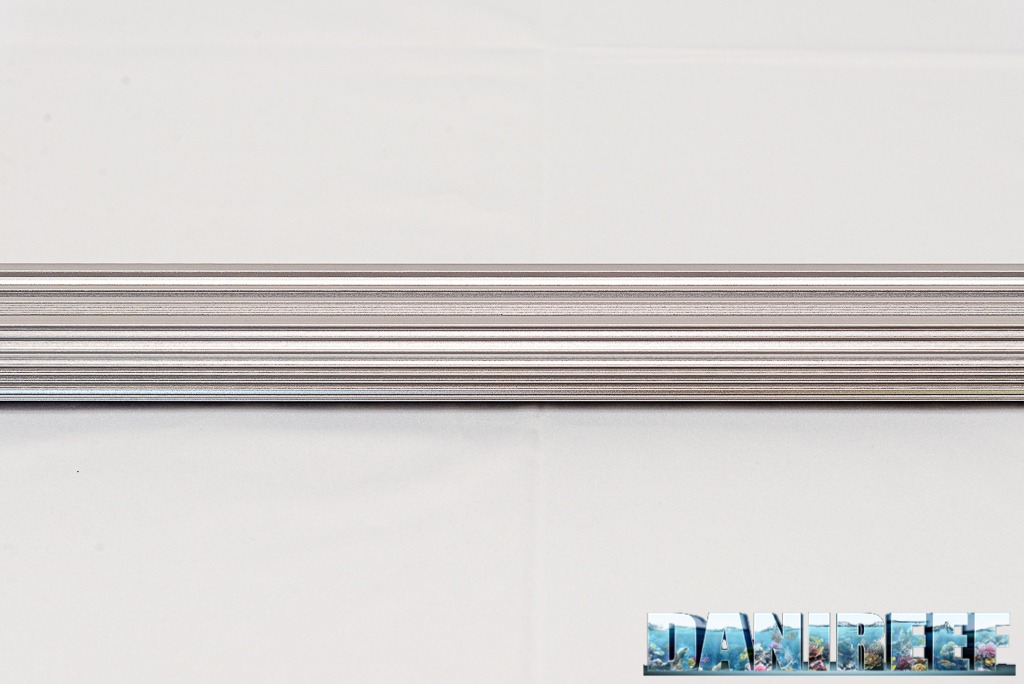
The Programming
LED bars generally are not programmable, and the Orphek OR3 are no exception, at least for today. Some competitive bars come with, or have available for purchase separately, a controller that allows them to be dimmed on, off, and as total intensity. Orphek has long announced the arrival of a dimmer, and we are just testing it for you, soon you will also find the article of the long-awaited Osix. By the way with LED bars, in my opinion, the problem is relative. Since the spectrum is decided by the bars you pair, and dimming can be implemented in a similar, though not equal, way by turning on one bar at a time. Mind you, I am not saying that the dimmer is useless, far from it, but that the lack of it weighs much less than when it comes to ceiling lights.
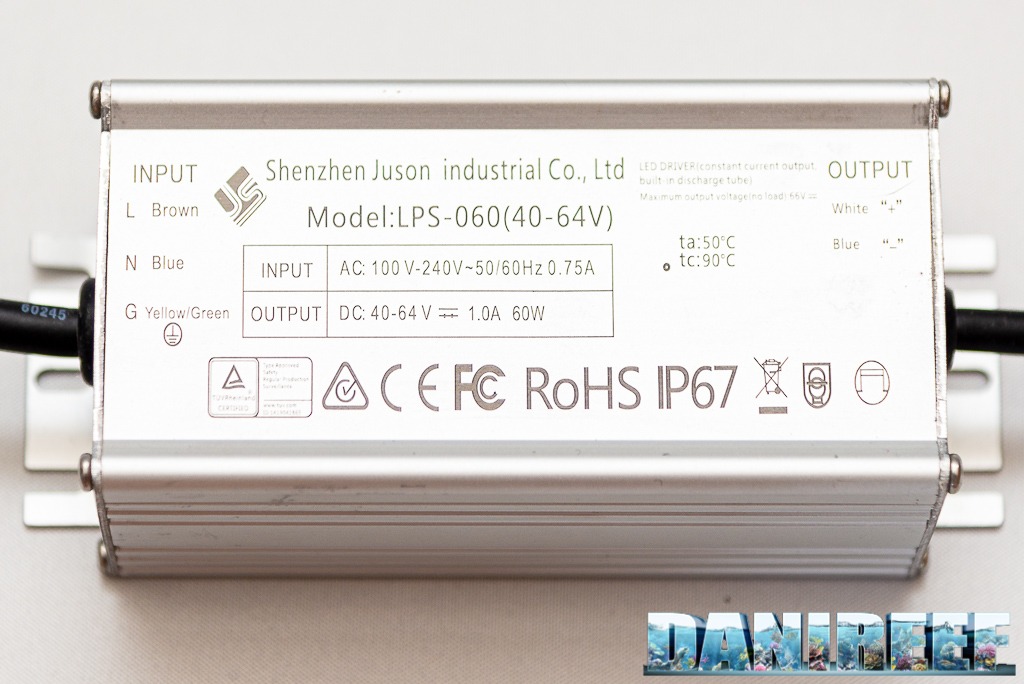
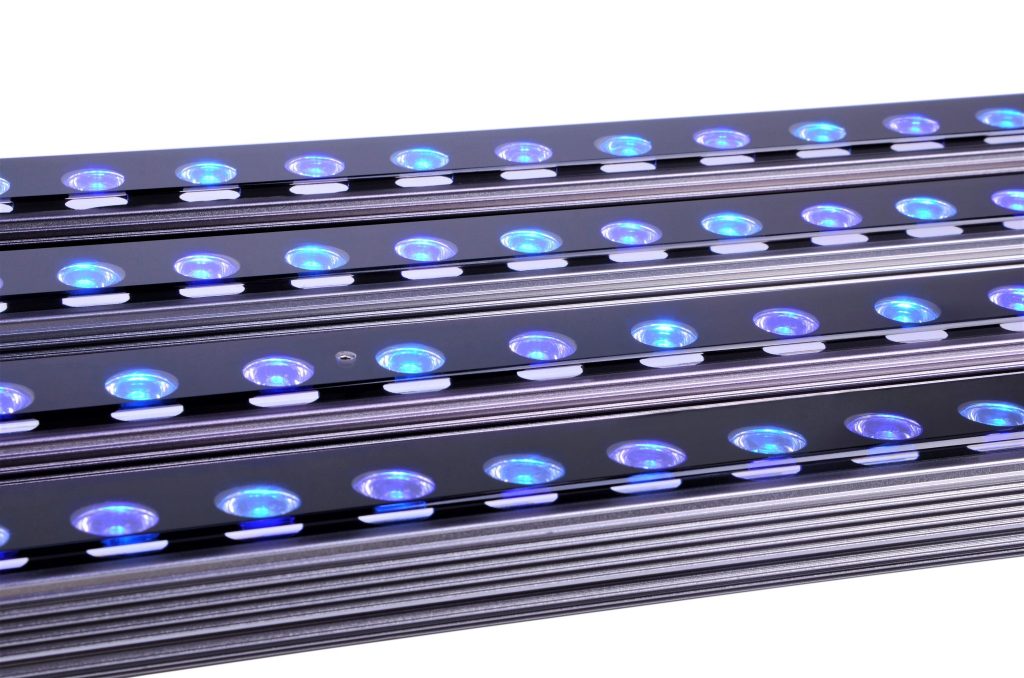
Unlike usual, we cannot give you the power consumption and values of the various LED channels, because the bars of LEDs all light up simultaneously.
Our new DaniReef LAB working method for measuring PARs
In the long nights spent on our forum (here) we have always wondered how to compare the PAR values of different ceiling lights. Until now, although we have the appropriate instrument, the Quantum Meter MQ-500 from Apogee, we have always referred to the value measured at the center about 20 cm away from the ceiling light.
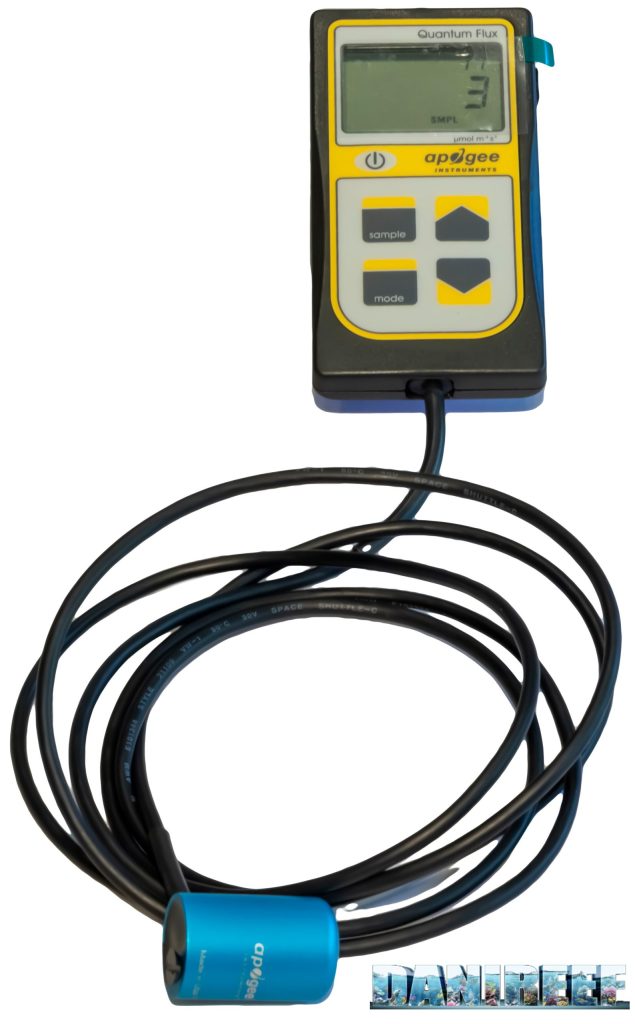

The Quantum Meter MQ-500 measures the PAR, expressed in PFFD or photosynthetic photon flux density in μmol m-2 s-1. This instrument is calibrated to work out of water, so used in water the measured value must be multiplied by 1.32, which is the immersion factor. Since there is no water at the time of the tests, we don’t need to do the conversion. The values that you will see will always be the correct ones.
So we decided to construct a 70×70 cm base, where we indicated 25 fiducial points to place the sensor of the Quantum Meter MQ-500. In order to place the ceiling plate, we created elevations of 20, 40, and 60 cm. So that the values will always be read at the same distance from the sensor. This will allow us to create curves in space that can be compared with those of other ceiling lights, again at the given distances. Note that this distance is measured between the base of the sensor and the base of the ceiling light. Actually, the distance needs to be decreased by 3.5 cm which is the height of the measuring cylinder and increased by 0.5 cm which is the size of the spacers that allow us to hold the ceiling light fixture up.
In total, the three measurements will then be taken at 17, 37, and 57 cm apart, in air, and the correction factor will be applied.
The measurement of PARs at a distance of 17 cm
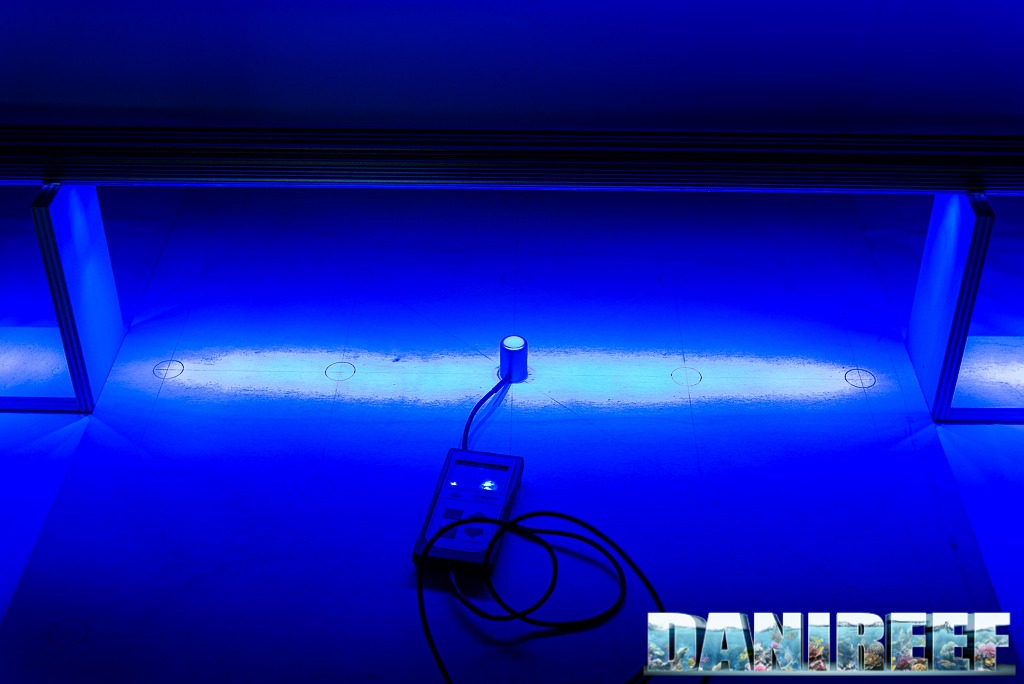
This is the test situation. Below you see the board and the tool, and above you catch a glimpse of the bar (in this case a OR3 Blue Sky) resting on the spacers.
These are the measured values:
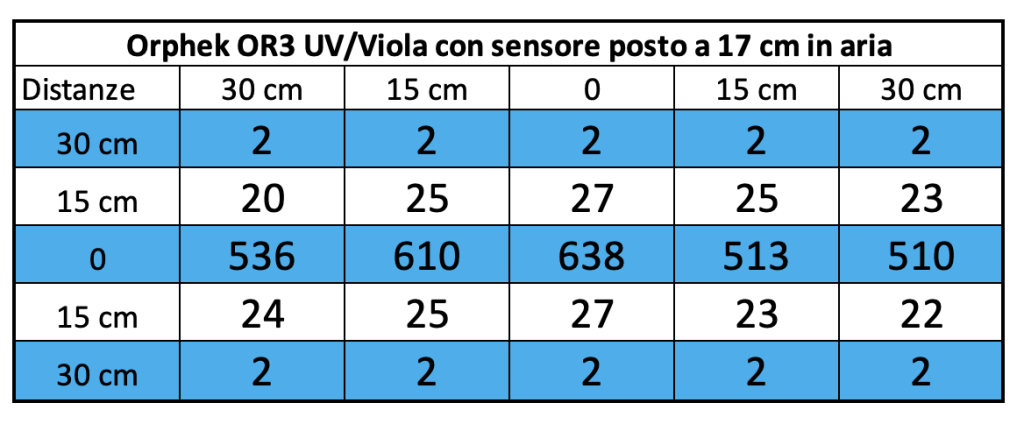
And this is the corresponding graph; for uniformity we will use the same scale for ceiling lights of homologous class, in this case talking about bars we have lowered the value of the maximum scale. In the next bars you will find the same rating scale.
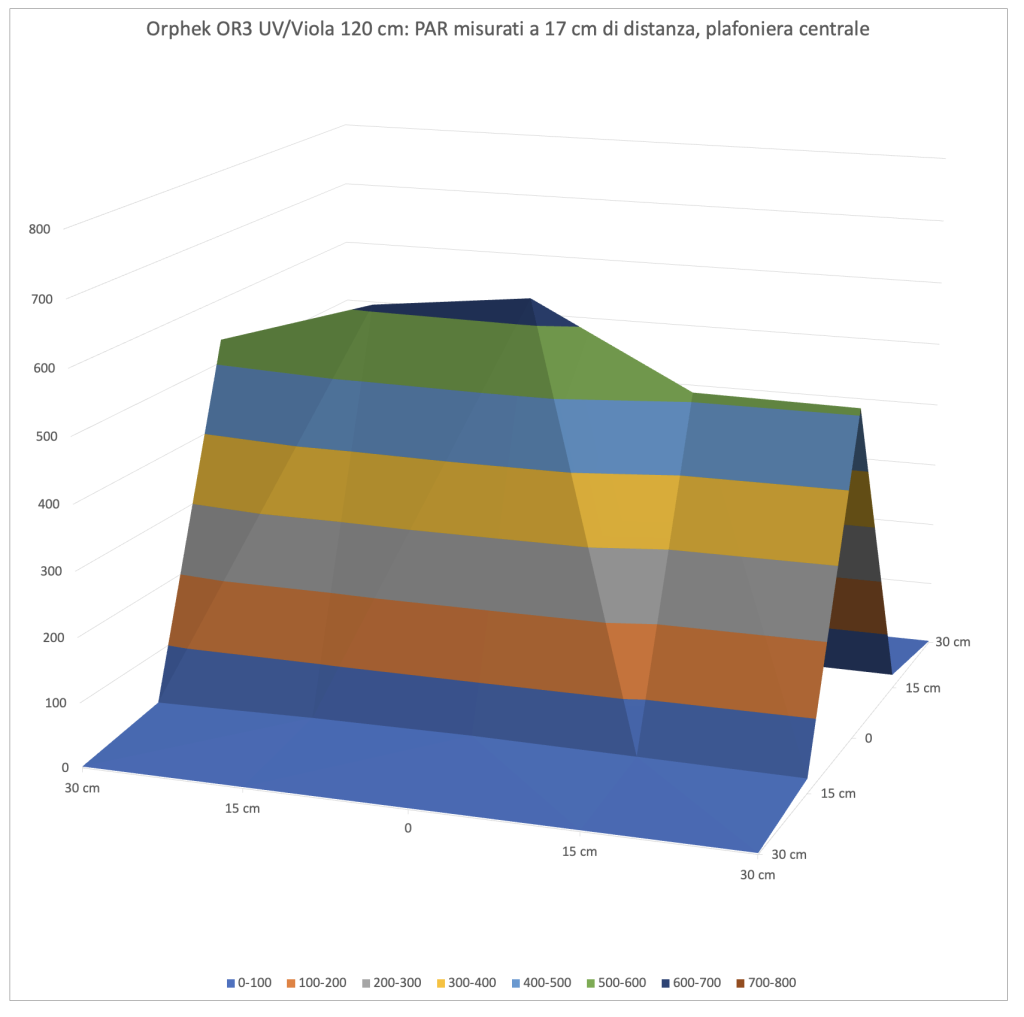
As can be seen, the bar creates a curve that resembles a curtain, with the spatial differences due to the type of LEDs used. Unlike classic ceiling lights therefore the decay is very linear, being about 20 cm from the light source. Curiously, on the right side of our specimen the PARs decrease somewhat compared to the center, probably depending on the type of coloration prominent on that side.
Let’s see the differences with the graphs of the LED bars tried to date. Remember that the scale is the same.
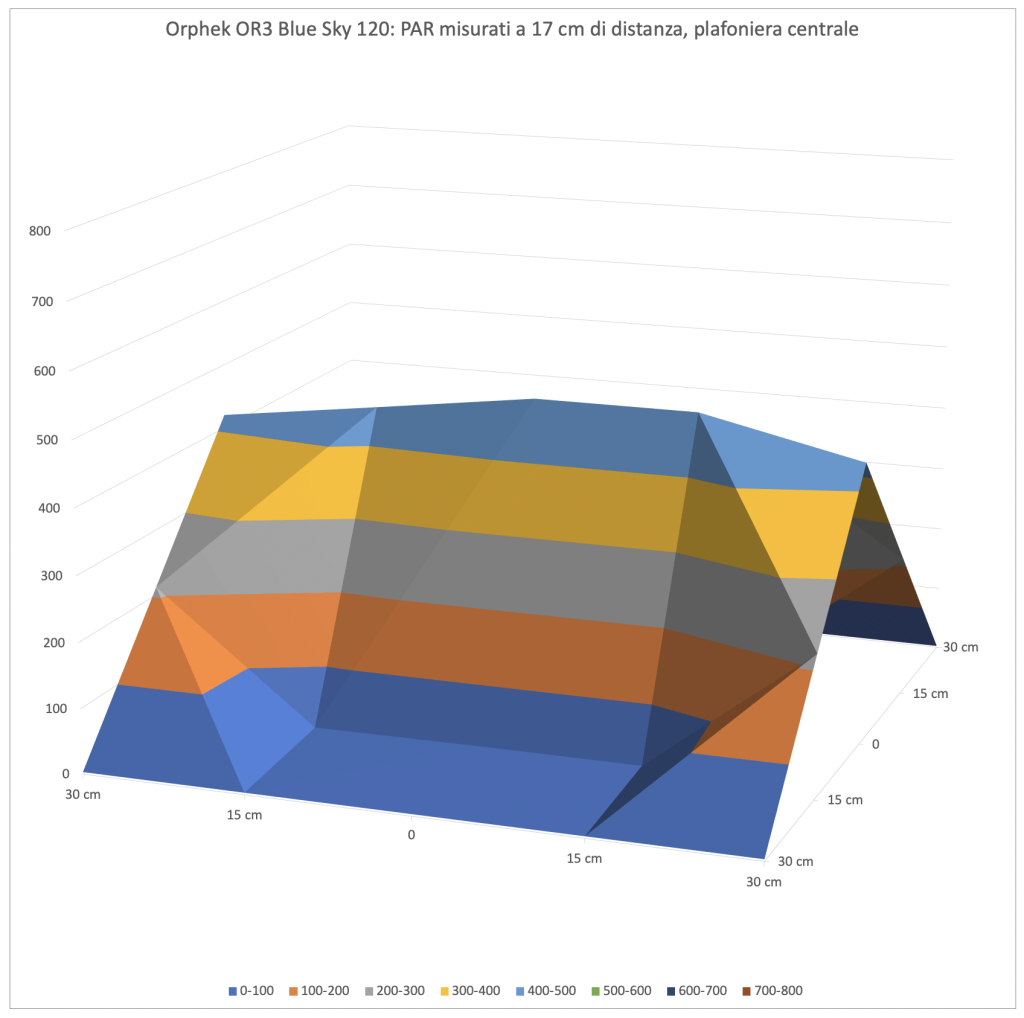


The behavior is similar to the other bars tested, with the OR3 UV/Violet having a peak PAR value only slightly lower than the Reef Day Plus but higher than the Blue Sky, and it is amazing when we think about what a huge difference in brightness we perceive with our eyes. Also noticeable is the difference with the Reef Flare S from Reef Factory, which, however, is just 60 cm long so the decrease in PAR at the edges is normal.
The measurement of PARs at a distance of 37 cm
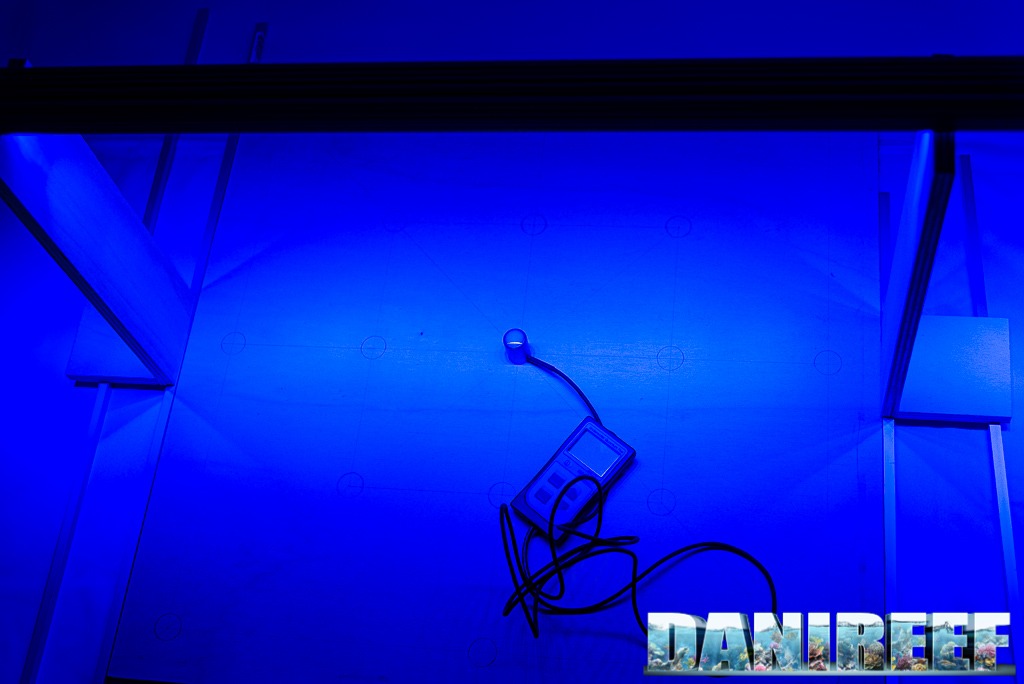
This is the test situation. Below you see the board, and the tool, and above you catch a glimpse of the bar (in this case a OR3 Blue Sky) resting on the spacers.

And this is the corresponding graph, for uniformity we will use the same scale for ceiling lights of homologous class, that is, similar in power and type.
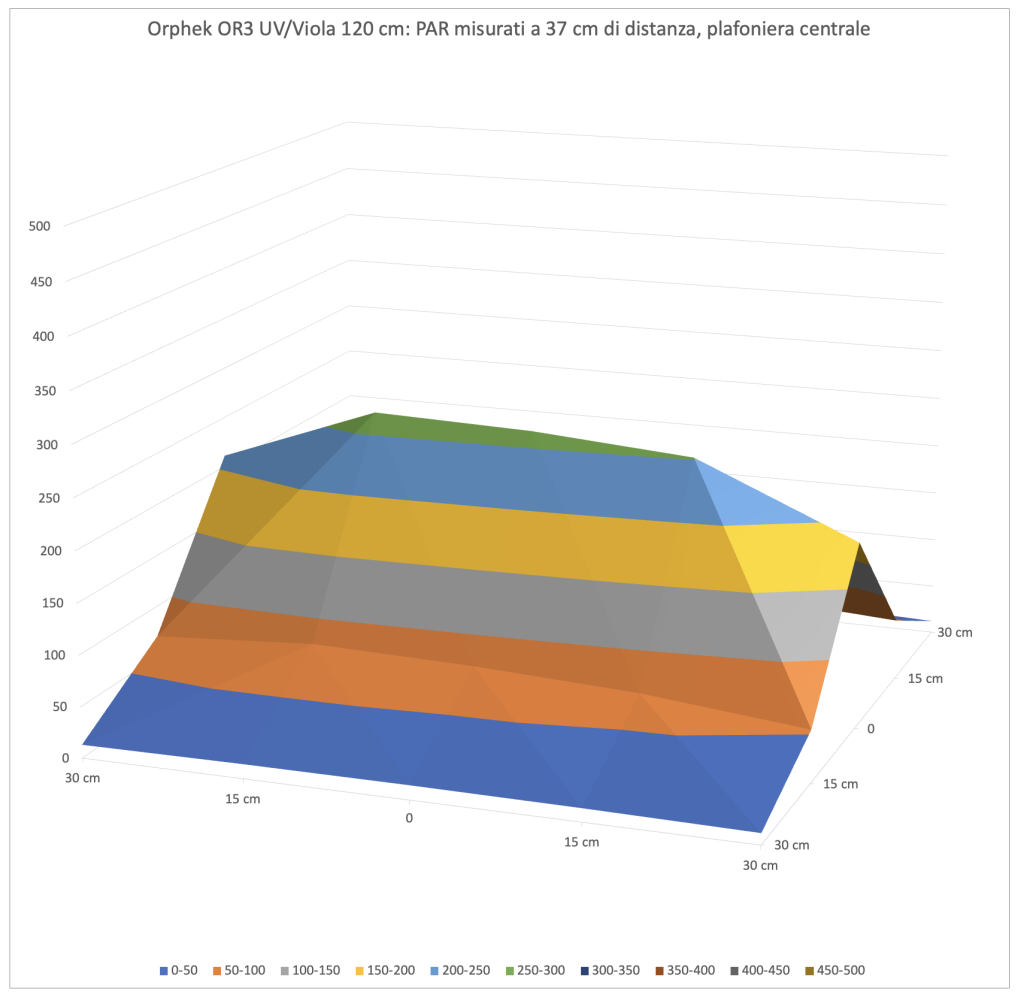
As the space between the ceiling light and the sensor increases, the difference between the PARs measured at the center and at the edges decreases. The light expands greatly, but the central value decreases from 638 to 264 μmol m-2 s-1, taken at the two brightest points.
It jumps out at you that the coverage is very full and much more linear. There remains this small offset to the center right.
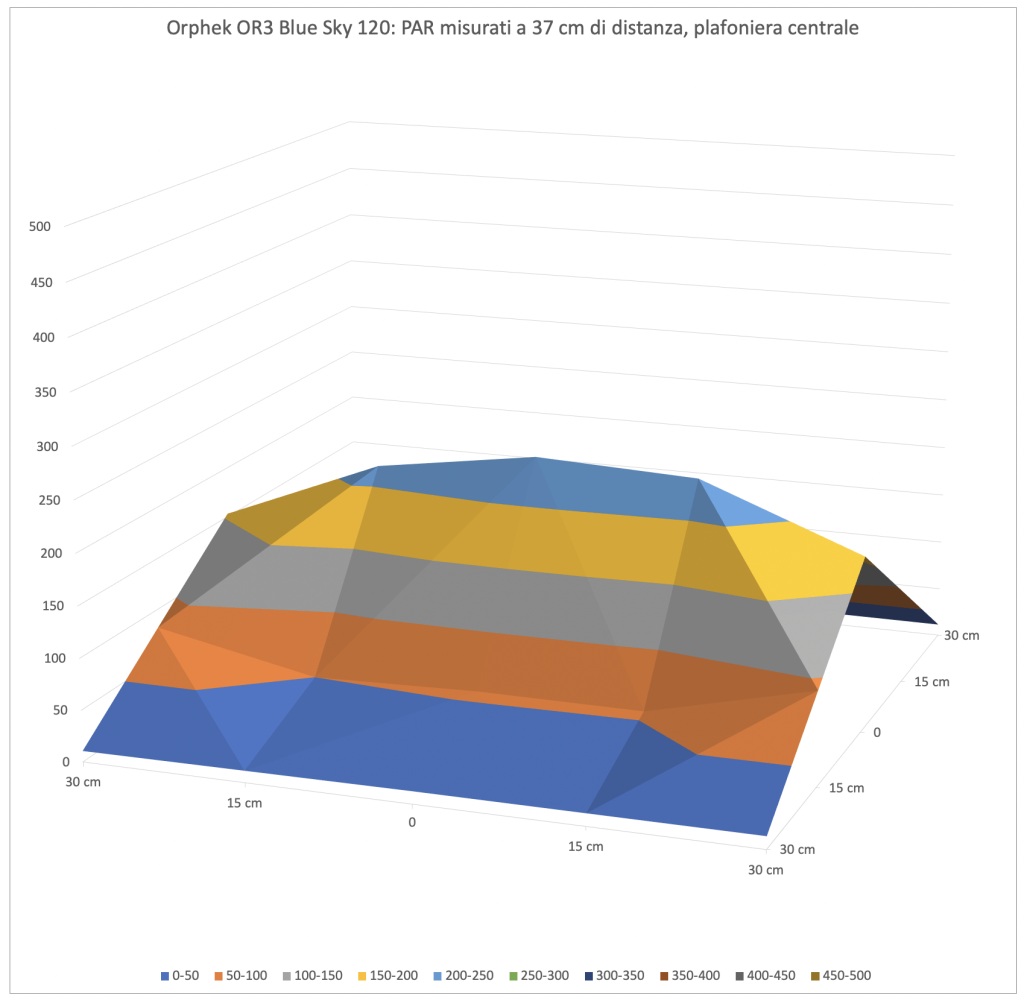
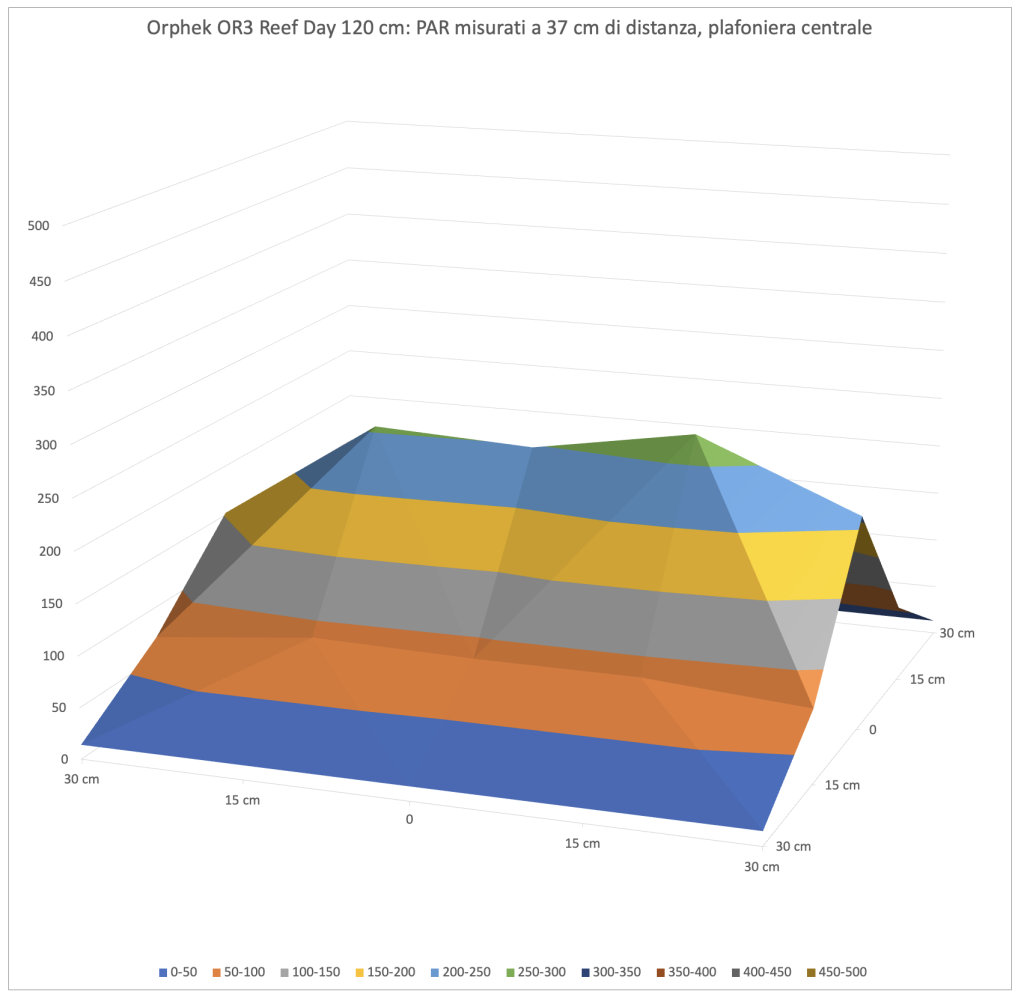

Again, the PAR value is almost at the levels of Reef Day, and higher than Sky Blue and ReefFactory’s Reef Flare Blue.
The measurement of PARs at a distance of 57 cm
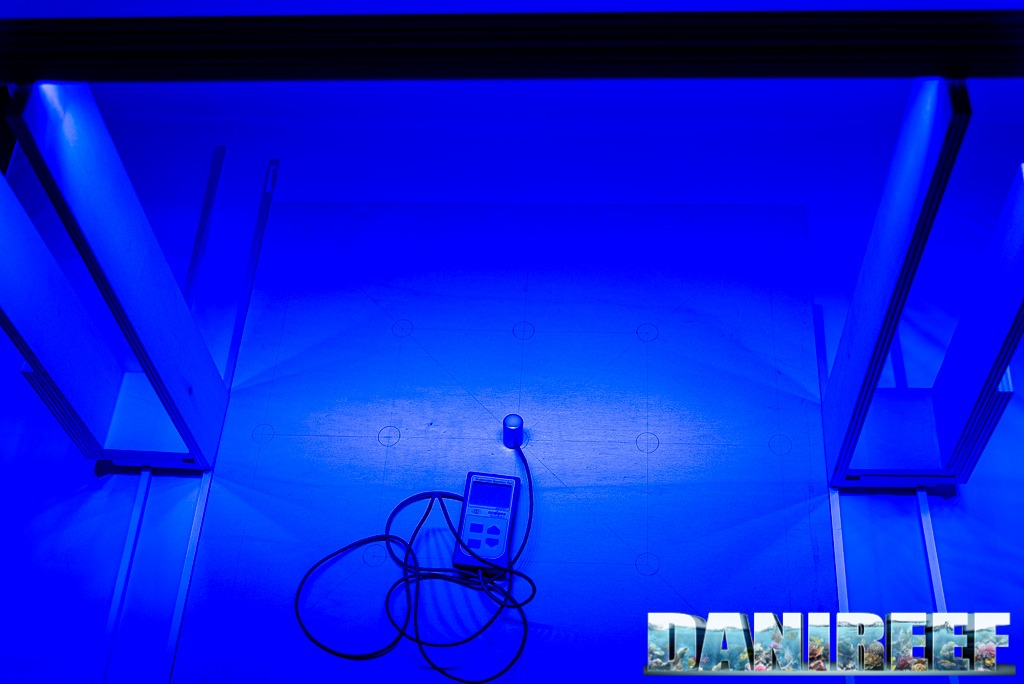
This is the test situation. Below you see the board, and from this distance you can see the instrument very well, and the ceiling light fixture resting on the spacers. Visually, the illuminated area is extremely large, and thus decreases the specific power per cm (in this case a OR3 Blue Sky).
These are the measured values:

And this is the corresponding graph, for uniformity we will use the same scale for ceiling lights of homologous class, that is, similar in power and type.

Increasing the space between the ceiling light fixture and sensor again, the spatial PAR distribution remains very uniform, with only a small longitudinal dip as was to be expected. The uniformity is practically perfect. The central value still decreases from 638 to 264 to 163 μmol m-2 s-1.
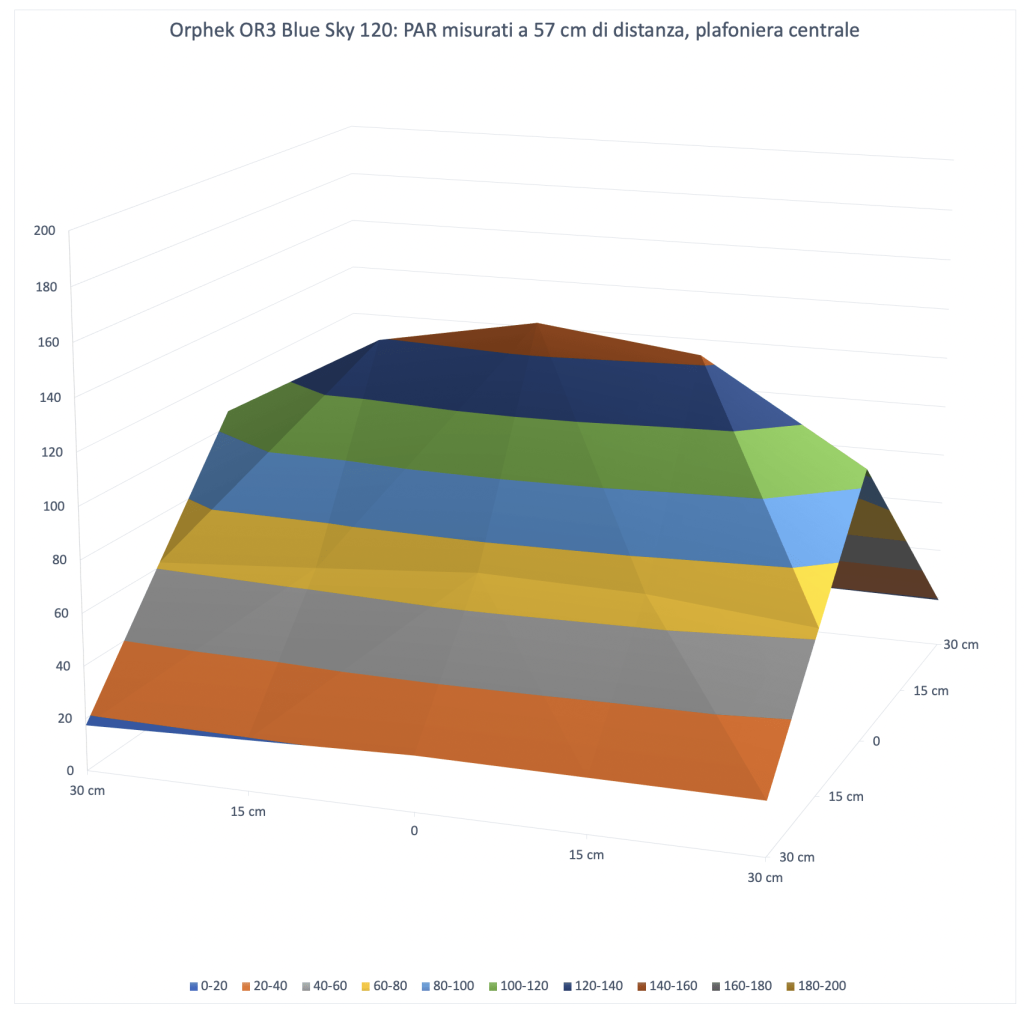

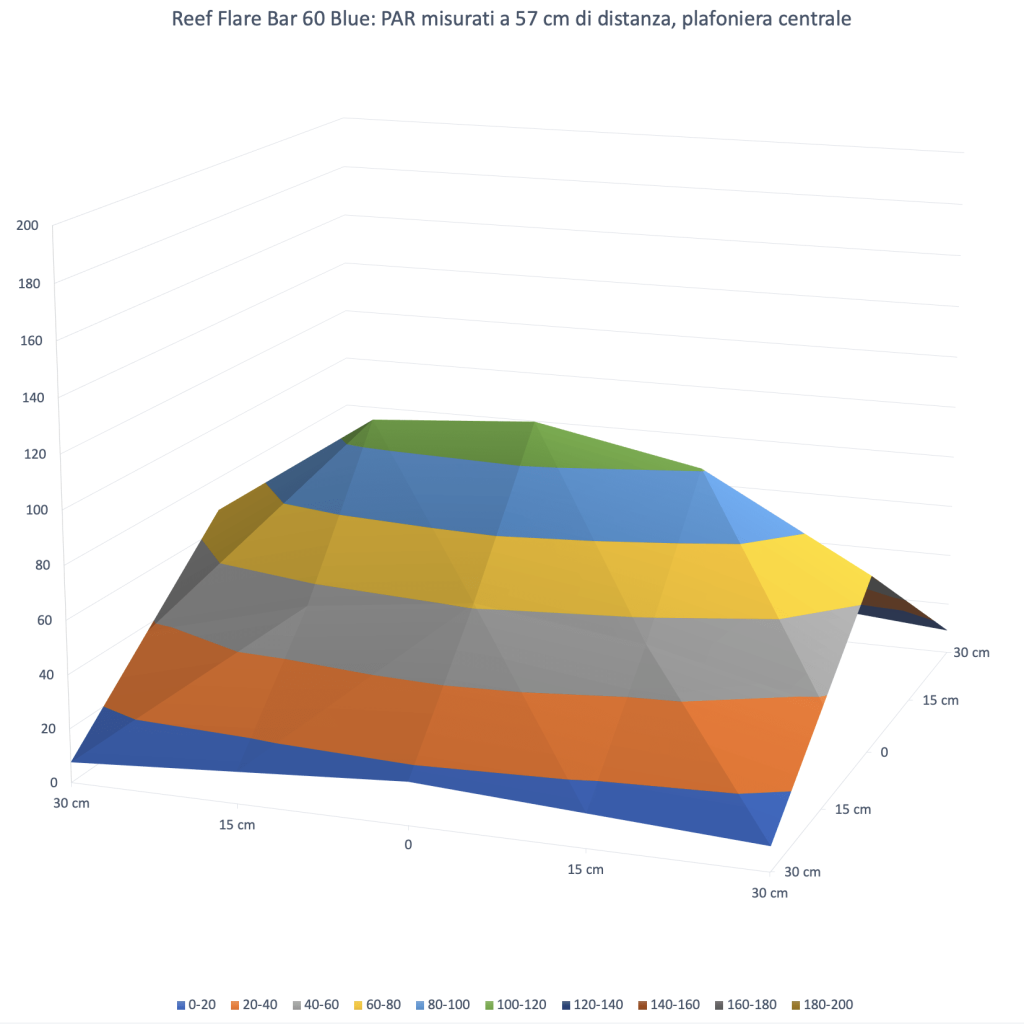
The comparison between the three bars increases again, much in the center where even the OR3 UV/Violet is the best performing of all, more than we would have expected, while at the edges the difference is minimal.
PARs in the center of different configurations
We continue with our technical measurements. Next we see how in a graph, the PAR measurements drop at the center in the three different distances of the test.
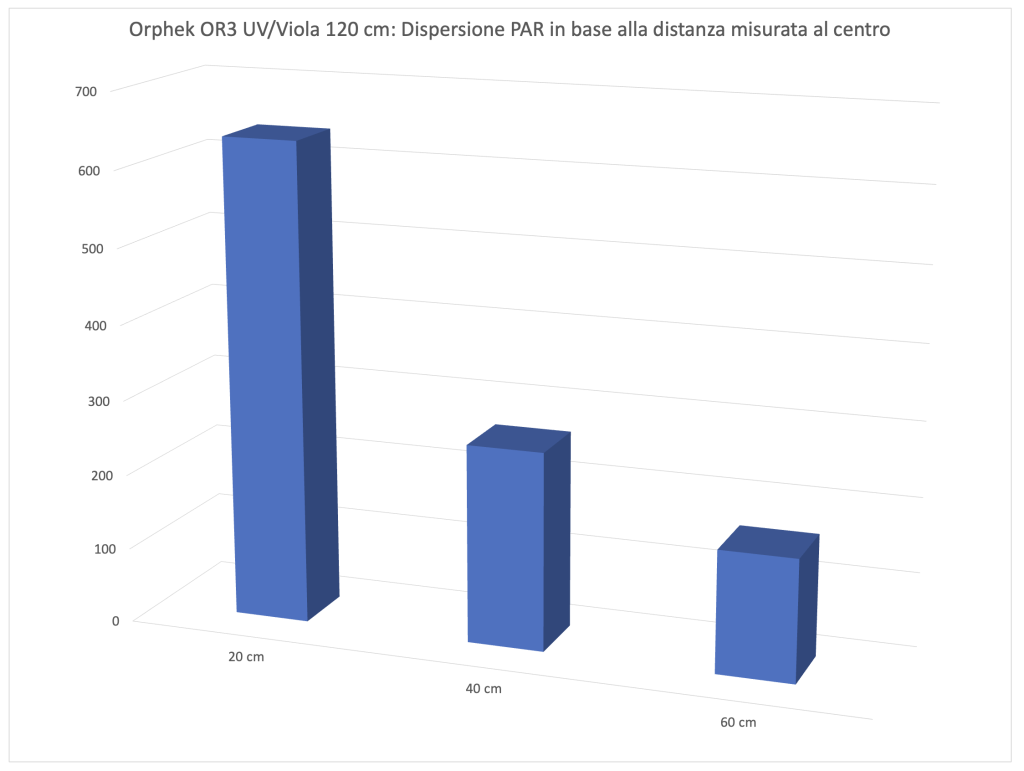
Energy Variation of Orphek OR3 UV/Violet LED Bars by Distance

This, in my opinion, is the most significant data among those measured, and the most comparable. The energy variation. The volumes subtended by the three surfaces you saw previously were calculated. Because it is obvious that by moving away from the ceiling light the PAR values drop, but they also drop because the light illuminates a larger space. In this way you try to account for all the light energy contained in the hypothetical 60-cm square subtended by the ceiling light fixture. And you can see that the three values 303,000, 252,000 and 235,000 take on a different connotation than the values measured in the center. When the former decrease a lot because the distances increase, the subtended area, that is the energy, decreases very slowly. The differences between the three areas is very small indeed. Little energy is sent out of the subtended area.
In fact, looking at the values of the three curves, at the edges there is much more light at 57 cm than at 37. Also remarkable is the fact that the energy at 37 and 57 cm is virtually the same.
How to evaluate these numbers in the aquarium?
This is a good question, in the sense that initially we thought we could translate these numbers to the aquarium tout-court. Then we filled an aquarium with water, submerged the probe, and did some measurements again. This made us bewildered, but, as we have mentioned in previous articles, we will discuss this in a forthcoming follow-up article, which we will then be sure to link below. Basically, while at 20 cm the result is practically coincident, as you submerge, thanks to the glass reflecting the light, and the water itself diffusing it more, you can find values even double those measured in air. Obviously this is not a detail that can be standardized, so we believe that our calculation methodology is the most correct, and the best for comparing the coverage of different ceiling lights.
Consumption
The lamp Orphek OR3 UV/Violet has a power consumption of 60 watts.
The calculation of the absorbed current and thus the power turns out to be as follows:
Ceiling light Orphek OR3 UV/Violet: 60 watts. Considering that at 17 cm the ceiling light develops at most 638 μmol m-2 s-1, it can be said, in perspective, to have a peak value of 10.63 μmol m-2 s-1 w-1 (PAR per watt). This value is difficult to compare with a ceiling light because it is more or less constant along the entire length.
Comparison with other ceiling lights on the market
Measurement data referred to the Quantum Meter MQ-510/MQ-511 from Apogee.
Considering the LED bars we have tested to date, we can make an interesting comparison on the energy produced.
| Energy | Cost | Consumption | Energy/€ | Energy/w | |
| ASF Proten LED Reef Blue at 17 cm | 138,000 | 130 | 27.80 | 1,060 | 4,956 |
| ASF Proten LED Reef Blue at 37 cm | 93,000 | 130 | 27.80 | 718 | 3,357 |
| ASF Proten LED Reef Blue at 57 cm | 60,000 | 130 | 27.80 | 464 | 2,166 |
| Orphek OR2 Blue Plus 120 cm at 17 cm | 323,000 | 180 | 54.69 | 1,794 | 5,906 |
| Orphek OR2 Blue Plus 120 cm at 37 cm | 291,000 | 180 | 54.69 | 1,616 | 5,321 |
| Orphek OR2 Blue Plus 120 cm at 57 cm | 259,000 | 180 | 54.69 | 1,438 | 4,736 |
| Orphek OR3 Blue Sky at 17 cm | 318,000 | 200 | 62.04 | 1,590 | 5,129 |
| Orphek OR3 Blue Sky at 37 cm | 221,000 | 200 | 62.04 | 1,103 | 3,449 |
| Orphek OR3 Blue Sky at 57 cm | 206,000 | 200 | 62.04 | 1,027 | 3,211 |
| Orphek OR2 Reef Day Plus 120 cm at 17 cm | 255,000 | 180 | 54.69 | 1,418 | 4,667 |
| Orphek OR2 Reef Day Plus 120 cm at 37 cm | 233,000 | 180 | 54.69 | 1,292 | 4,252 |
| Orphek OR2 Reef Day Plus 120 cm at 57 cm | 225,000 | 180 | 54.69 | 1,251 | 4,117 |
| Orphek OR3 Reef Day Plus 120 cm at 17 cm | 294,000 | 270 | 60 | 1,087 | 4,892 |
| Orphek OR3 Reef Day Plus 120 cm at 37 cm | 261,000 | 270 | 60 | 965 | 4,343 |
| Orphek OR3 Reef Day Plus 120 cm at 57 cm | 253,000 | 270 | 60 | 937 | 4,218 |
| Orphek OR3 UV/Violet 120 cm at 17 cm | 303,000 | 300 | 60 | 1,012 | 5,058 |
| Orphek OR3 UV/Violet 120 cm at 37 cm | 252,000 | 300 | 60 | 840 | 4,200 |
| Orphek OR3 UV/Violet 120 cm at 57 cm | 235,000 | 300 | 60 | 785 | 3,922 |
| Reef Flare Bar Blue S at 17 cm | 202,000 | 220 | 24.34 | 918 | 8,299 |
| Reef Flare Bar Blue S at 37 cm | 177,000 | 220 | 24.34 | 804 | 7,272 |
| Reef Flare Bar Blue S at 57 cm | 155,000 | 220 | 24.34 | 704 | 6,368 |
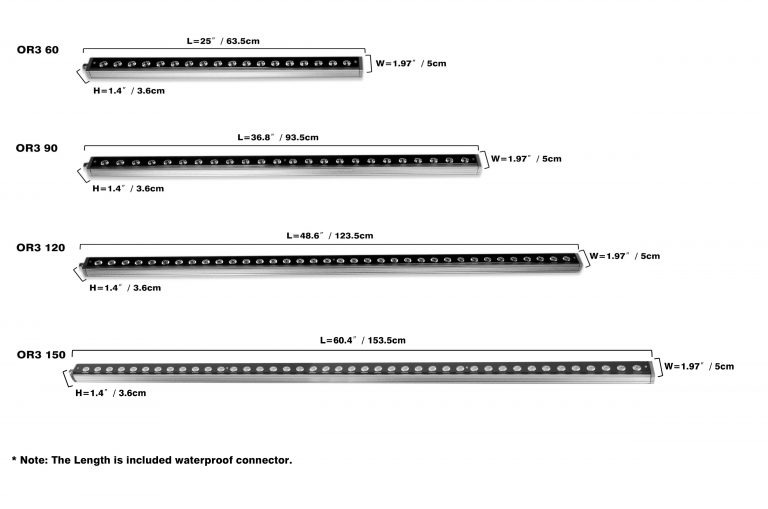
With the OR3 UV/Violet we get an incredible PAR value; even at a distance of 57 cm, compared to any other solution, so we can advise you to be very careful how much you talk about UV in aquarium. You do not see the strong brightness witnessed by the PAR values, but the corals do! Compared to the other bars the PAR level is still benchmark, losing something only from the total energy of the Blue Plus and the Blue Sky. Unfortunately, the price has increased compared to the previous bars, because they have switched from direct purchase to purchase through a distributor, in this case the optimal AGP, though now they offer a 2 year warranty instead of one limited one, and direct management. In any case the output remains competitive, and indeed better on paper as efficiency, for example, than the Reef Flare.
Maintenance Costs
The LED rods Orphek OR3 UV/Violet cost about 300 euros, slightly more than the 270 euros charged for other OR3. On the Orphek website they are sold for $210. The price looks different, but in fact it is not. In the sense that to the $210 you have to add VAT and customs duties for about 32% of the total, thus bringing the price to $277, with the taxes and duties that would be paid to the courier and not to the order. True, the euro-dollar exchange rate does make something back, but you would save about 23 euros per ceiling light but considering that buying them in Italy you have the full warranty for two years, versus a limited warranty of only one year. In my opinion it is cheaper today to buy them in Italy. And not by a small amount.
The power input can considered to be 60 watts, so a cost/watt ratio of about 5 euros per watt. To make a comparison with other ceiling lights we have had on our hands, simply refer to the following table.
| Ceiling lamp | Price | Consumption | Euro per watt ratio |
| Orphek OR3 Blue Sky | 200 USD | 62 w | 3.2 euros per watt |
| Orphek OR2 Blue Plus | 180 USD | 54.7 w | 3.3 euros per watt |
| Orphek OR2 Reef Day Plus | 180 USD | 54,7 w | 3.3 euros per watt |
| Cetus 2 | 215 € | 60,7 w | 3.5 euros per watt |
| Philips Coralcare 2019 | 749 € | 190 w | 3.9 euros per watt |
| Maxspect Ethereal | 500 € | 126 w | 4.0 euros per watt |
| Orphek OR3 Reef Day Plus | 270 € | 60 w | 4.5 euros per watt |
| ASF Proten LED Reef Blue 90-120 | 130 € | 27,8 w | 4.67 euros per watt |
| Radion XR30w G2 PRO | 790 € | 170 w | 4.7 euros per watt |
| AI Hydra 32 HD | 430 € | 90,5 w | 4.75 euros per watt |
| Radion XR30w G4 PRO | 915 € | 190 w | 4.84 euros per watt |
| OceanLed Sunrise 600 | 870 € | 180 w | 4.8 euros per watt |
| Orphek Atlantik V4 | 1099 € | 226 w | 4.9 euros per watt |
| Radion XR30w G2 | 690 € | 140 w | 4.9 euros per watt |
| Orphek OR3 UV/Violet | 300 € | 60 w | 5 euro per watt |
| Radion XR30w G4 | 760 € | 150 w | 5.1 euros per watt |
| Aqamai LRM | 465 € | 87,5 w | 5.1 euros per watt |
| Zetlight UFO ZE-8000 | 500 € | 91,5 w | 5.5 euros per watt |
| Aqamai LRS | 289 € | 47,6 w | 6.1 euros per watt |
| Reef Flare Bar Blue S | 220 € | 24,34 w | 9 euros per watt |
| CEAB Slide & Led | 2.700 € | 275 w | 9.8 euros per watt |
| Sicce GNC 466 | 1.592 € | 120 w | 13.3 euros per watt |

As we have already had occasion to say for its Orphek OR3 sisters, the LED bar is simply impeccably constructed. Solid, massive, and very well assembled. I really like the extruded profiles as well as the finish. The fact that it has no programming ensures perfect ease of operation, either on or off, plus you can put several side by side until you get the power you need. Measured PARs must be thought of in this context, since the comparison with a ceiling light is obviously rather merciless in favor of ceiling lights. But already if one were to consider the total energy, the numbers begin to add up, even considering that the light adds up between the different sources. So the bars are perfect for growing any coral, the important thing, is to flank a congruent number of them. Do you want to double the PARs? Flank two; want to quadruple them? Flank four, and so on. I personally believe that 4 LED bars should be able to get us up to about 600 PARs in an average aquarium, varying with depth, a value that allows us to breed Acropora of any complexity.
The cost per watt is average, in line with previous ones considering vat and duty, while on PARs per watt we are at a very good level. Better even than some competitive Blue ceiling lights. What else to ask from an LED bar?
[Translated by Aisja Baglioni]










0 Comments